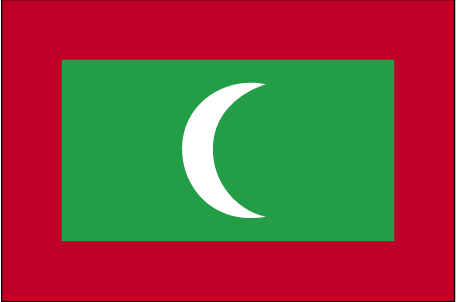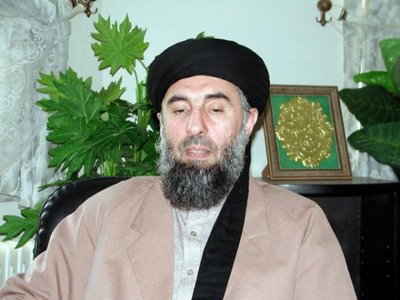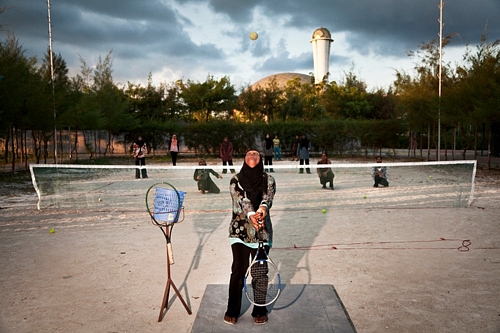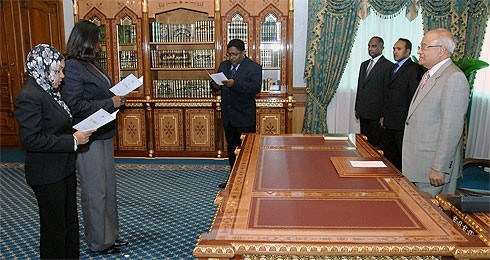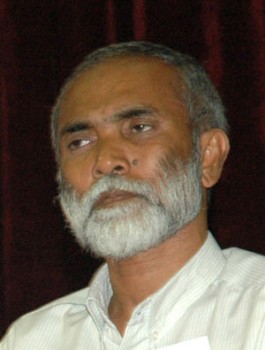This article is written by Aishath Muneeza, a Post Graduate Student, Harun M. Hashim Law Centre, International Islamic University Malaysia.
MALAYSIA
Abstract
The purpose of this research is to enlighten one of the contemporary legal dilemmas in Islamic law namely, the appointment of female judges in Muslim countries. The methodology employed is library based research. The focus of this research is to determine the legal status of appointments of female judges in Shari’ah courts. It is argued here that female judges can be appointed in Muslim countries and that the main reason for this is the fact that there is no explicit prohibition of it in the fundamental sources of Islamic law. However the claims that it is contrary in Islamic law to appoint female judges are also discussed here. The outcome of this research is to prove that there is nothing wrong in Islam to appoint female judges, as long as they fulfill the conditions necessary.
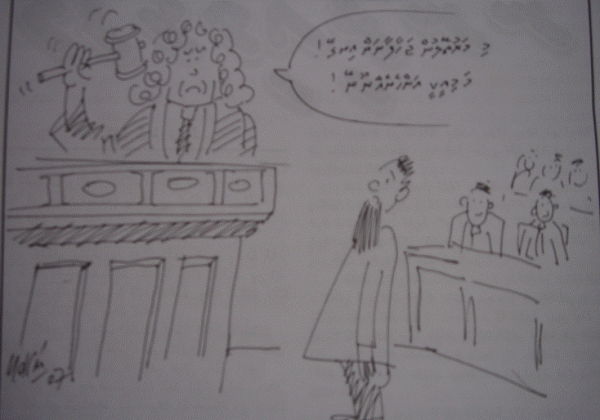
Cartoon published in Fiyes Magazine, 30 May 2007, No. 236
Introduction
Appointment of female judges has become a contentious issue in all of the Muslim nations including Malaysia. Today, countries such as Sudan, Egypt, Tunisia, Yemen, Bangladesh, Pakistan, Indonesia and Maldives has altered their procedure on this aspect by choosing female judges to preside in the courts, but there is no end to the deliberations of the religious groups. These deliberators tag along the observations specified by the classical scholars of Muslims, who based their views on the interpretations of the verses of the Quran and Sunnah.[1]
Mohamed Hamed al-Gemel, the former president of the Fatwaa Council of Egypt stated;
“There is no specific provision in the Qur’an or Sunnah proscribing the appointment of female judges, so the interpretation depends on the rulings of contemporary jurists.”[2] This shows that the issue of appointment of female judges in Muslim countries is open for interpretation.
It has to be understood here that gender has nothing to do with this and anyone can be a judge if they are qualified. Apart from their academic qualifications, they must also be mentally strong. This view has been supported by Prof Datuk Shukor Husin, Council chairman of the National Fatwa Council of Malaysia. He stated that women could be appointed as Syariah judges provided that their selection was based on their abilities, integrity, qualifications as well as experiences.[3]
In this endeavour to analyze this matter, the topic has been divided into several headings. The very first thing which has been discussed in this work is the observations of classical jurists. This is to ensure that the readers comprehend the fundamental views about the issue, before reading the depth analysis. After this, the grounds on which female judges could be appointed in Islamic countries have been discussed. Before concluding this research work, attempt has been made to refer to the contemporary developments of this issue in some of the Muslim countries.
It is argued here that though the appointments of female judges in Muslim countries remain a controversial issue due to the general misperception that such appointments might not be in conformity with Islamic law, it is consistent with Islamic law as there is no explicit Quranic verse or tradition of the prophet (SAW) prohibiting it.
Observations Of The Classical Muslim Jurists
The majority view (jumhur) among the founding jurists (mujtahid mutlaq) of Imam Shafii, Malik and Ibn Hanbal regarded women as being ineligible as judges based on an interpretation of Surah an-Nisa’ 4:34, that men are qawwamuna (protectors) over women.
The minority view of Imam Abu Hanifah, however, opined that the authority of a judge is not valid unless he possesses the qualifications necessary for a witness. Thus this opinion allows women to be judges in all cases except hudud and qisas cases. This flows from Imam Abu Hanifah’s interpretation of Surah al-Baqarah 2:282, on women’s eligibility to be witnesses in commercial transactions.
There were also the individual views of other jurists such as al-Tabari and Ibn Hazm which stated that a woman can be a judge in all cases without exception as long as she fulfils the requirements for the position. This would also appear to flow from a reading of Surah al-Taubah 9:71, that believing men and women are each other’s awliyya (protecting friends and guardians).
Grounds On Which Female Judges Can Be Appointed As Judges
In this paper two grounds on which female judges could be appointed in Muslim countries would be discussed. They are:
(a) No explicit prohibition can be found in Qur’an and Sunnah.
(b) Islam does not inferiorize women.
No Explicit Prohibition Can Be Found In Qur’an And Sunnah
There are no statements in the Quran and Sunnah depriving women from acting as judges. Each of these sources of Islamic law would be analyzed separately.
Qur’an
In Quran there is no single verse prohibiting the appointment of female judges. The verses interpreted by scholars to prohibit have no relevance to the matter at all.
Surah an-Nisa’ 4:34 is the parent source from which all juristic opinion of the status and position of women is derived by the opponents.
Surah an-Nisa’ 4:34 states to the effect that:
Men are qawwamuna over women, (on the basis) that Allah has (faddala) preferred some of them over others and (on the basis) of what they spend of their property (for the support of women) …
This verse has been misconstrued to mean that men have power over women and that all men are superior to women. The Qur’an institutes men responsible over women. It does not mean that women are incapable of handling their own affairs as though they lack the capacity. It does not mean that women are incompetent to handle leadership roles. Rather, it intends to establish the responsibility of men for the protection and maintenance of women in a restricted setting or social context. Biologically, only women can bear the future generations of Muslims. The Qur’an creates a harmonious balance in society by establishing a functional responsibility for males to facilitate this biological function of females. The material responsibility of men in the Qur’an is that they are vested with the responsibility to facilitate this biological function of females. This verse does not give men inherent superiority, but rather establishes mutual responsibility in society.
Furthermore, Qur’an does not say that all men are superior to or better than all women and nor that all men are preferred by Allah (SW) over all women. Advantages are explicitly specified in the Qur’an. Men have a certain advantage materially, resulting in certain responsibilities (or vice versa). When the Qur’an says that “some (unspecified gender) are preferred by Allah (SW) over others”, it uses general language which corresponds exactly with the observable reality in creation: some creatures have some advantages over others-even some humans over others. All men do not always have an advantage over all women, or all women over all men.
The view that a man is superior to a woman because he is physically “stronger” also lacks the support of the Qur’an and authentic Sunnah. The divine sources mention “care” and “responsibility” within the family, but not superiority. Muslim men and women are equal in their individual and social responsibilities, being in charge (protectors) of one another and of the whole society (awliyya), as stated in Surah al-Taubah 9:71.
Other than Surah an-Nisa’ 4:34, another verse that is repeatedly cited to entail women’s incompetence is Surah al-Baqarah 2:282, which states to the effect that:
Whenever you take credit for a stated term set it down in writing. And let a scribe write it down equitably between you … And call upon two of your men to act as witnesses; and if the two men are not available to you as witnesses, then a man and two women from among you, so that if one of them should make a mistake, the other could remind her …
This verse has been misinterpreted to prove the moral and intellectual incapacity of women. The context of this verse relates to a written loan agreement. The stipulation that two women may be substituted for one male witness does not imply any reflection on woman’s moral or intellectual capabilities. It is obviously due to the fact that (at the time of revelation) women were less familiar with business procedures than men and, therefore, more liable to commit mistakes in this respect.
The unfamiliarity of women at the time of revelation in personally conducting business transactions is demonstrated by the fact that even Khadijah (RA), the wife of the Prophet (SAW), left the charge of her business affairs to him. This was the socio-historical context at that time when the verse was revealed. To ensure justice therefore, two women were required for the following purpose: If the female witness errs or forgets, the other is needed, not to give evidence, but to remind her. This is quite acceptable, even today, when women still find the court process intimidating and require another to reassure them and provide moral support. This again corresponds to the observable reality. It should, in fact, be considered quite remarkable that despite the social constraints at the time of the revelation-inexperience and coercion of women-a woman was nevertheless considered a potential witness. In this modern era, such revolutionary consideration of women’s potential should lead to greater promotion of her contributions to a just and moral social system, and end exploitation of her and others in society.
Sunnah
The hadith that is often cited to deprive women of headship is a hadith related by Abu Bakra to the effect that:
When the news reached the Prophet (SAW) that the Persians had made the daughter of Chosroe their ruler he observed: That a nation can never prosper which has assigned its reign to a woman.
For hundreds of years, this hadith has been taken to mean by a majority juristic opinion that a woman cannot be a nation’s leader (khalifah), and as such she should not be allowed to be a judge (which is part of the function of a khalifah). This juristic opinion resulted in the regression of the status and position of women in society, to the extent that Muslim women were unable to equally enjoy the rights that were enjoyed by men. These rights included political rights and political participation, holding higher public offices, becoming witnesses, judges and leaders. Nevertheless, the other opinion which stems from this hadith allows women to be judges, but not leaders or heads of government.
Whatever the traditional interpretation, it must be noted that this hadith is classified as an ahad (isolated) hadith. This means that the narrators of this hadith do not exceed two persons in each generation. A mutawatir hadith, on the other hand, is one that is reported by an indefinite number of people in such a way that precludes the possibility of its being false.
The above hadith was narrated for the first time during the Battle of the Camel in which A `shah (RA) led her forces into Basrah. Her forces (which reportedly included Abu Bakra) were defeated. Many believers died in that battle.
Many modern-day commentators view this hadith as a fabricated hadith. If it had been a genuine hadith of the Prophet (SAW), Abu Bakra would have obeyed the injunction by not going out to battle under A `shah’s banner. The other explanation may be that the report was in the nature of a khabar (information).
In the context of the Battle of the Camel, Aishah was in command of the army which included many illustrious companions of the Prophet. None of them objected to her being in command, nor did they desert her for that reason. Even Abu Bakra, the narrator of the above hadith, did not desert her. Had he been convinced that the Prophet had prohibited women from being imam (leader or head) he should have deserted Aishah as soon as he recalled this tradition. How then could it be said that a woman cannot become leader of a government when her leadership was accepted by such eminent companions of the Prophet?
Those who have utilised the above-mentioned hadith for the proposition that a woman should not hold leadership positions have also cited a statement attributed to Aishah as saying:
It would be more to my liking had I remained in my house and not gone on the expedition to Basrah
If she made this statement, it could be because she regretted the loss of so many lives, including some of her nearest and dearest, and to the loss of her own prestige, and not necessarily that she was not supposed to lead.
It is a well-known principle in Islamic jurisprudence that an ahad hadith is not a basis for formulating binding rules and it is not necessary to act upon it. Hence, it is strange and illogical that this isolated tradition should have been made the basis for the ruling that a woman cannot become a head of state or be appointed as a judge, a ruling that has such serious implications on society in general as well as on women in particular.
The second hadith relied upon as impediments to the appointment of women to responsible positions are the tradition which declares women as “naqis al-‘aql wa al-din” (defective or imperfect in reasoning and religion). As stated by those who are well versed in discriminating between authentic and forged traditions, the forgery can in most cases be detected from the subject matter of the tradition. Thus, a hadith cannot be accepted as authentic if it describes what is impossible of occurrence and which is not acceptable to human reason, or if it is contrary to the Qur’an,or if it is contrary to historical facts.
The former Chief Justice of the Federal Shariat Court of Pakistan, Justice Aftab Hussein, referred to the view of Dr Abdul Hamid Mutawalli, who said that it is very apparent that this tradition is one of the thousands of traditions which were forged and ascribed to the Prophet (saw) falsely, as it contains all the three defects.[4]
Among the first generation of Muslims, women were involved in the transmission of Prophetic reports as well as the development of legal doctrine. The most prominent of these women was Aishah (RA). The fact that Aishah (RA) was a wife of the Prophet (saw) gave her privileged status as a transmitter of religious doctrine. It was her own qualities as an individual, however, that afforded her the authority to interpret law. Female participation in the production and reproduction of the religious sciences did not cease with the demise of the first generation of Muslims. Evidence of female participation in the public transmission of the hadith can be found in many diplomas (ijazas) containing women’s names and in the manuscripts that mention women as teachers and as students. There is some evidence that women also participated in the more speculative branches of the religious sciences, such as positive law and speculative legal philosophy. Al-Hattab, a North African jurist of the 16th century CE, mentions the names of his teachers, his teachers’ teachers, and the chain of authorities (isnad) that linked him to the authors of the various books that he had studied in his legal career. Two women appear in this chain of authorities, Zaynab bint al-Kamal al-Maqdisiyya al-Musnida and Umm al-Hasan Fatima bint Khalil al-Katani (or al-Kinani).
This fact of women’s recognised participation as intellectuals created awareness of the contradiction between the epistemological equality women enjoyed in the production and transmission of knowledge and their marginalised position in political contexts, whether as a witness or as a judge in a court of law. It also lessened the plausibility of any argument that sought to ground discrimination in the nature of the female. There are arguments in medieval Islamic legal discourse that defend the gender-based distinction against women in the political contexts by ultimately locating the source of this discrimination not within the woman, but rather in specific social circumstances and the role that women played within those social circumstances.
A witness’s testimony and a judge’s verdict are both political because the consequences of each are immediate, tangible and binding. Al-Qarafi’s argument noted the difficulty courts have in enforcing the law. This institutional argument is compounded by the fact that men (including himself) in his 13th century CE Egyptian society viewed women as being generally inferior to men. Subsequently, there is a greater likelihood that the losing party will not respect the court’s decision. Al-Qarafi’s second argument, that women are inherently deficient in reason and religion, is described as weak by Ibn al-Shatt (d. 1323 CE), because if one accepts this argument, this deficiency must also be present when a woman acts as a narrator of hadith. However, women are recognized as narrators of hadith, and also as mufti.
Interpretation of revelation was free of gender restrictions. A woman’s legal opinion (fatwa) was just as valid and morally binding as the legal opinion of a man. Thus a woman could legitimately be a mufti, a legal expert whose task it was to communicate legal rules to non-specialists including, at times, judges and other holders of political power. There was complete agreement among Sunni jurists that women could be mufti. It was as a result of the law’s acceptance of women as mufti, moreover, that al-Tabari was led to argue that a woman could be a judge in all areas of the law. There are also a number of historical instances about the exercise of jurisdiction of qadhi by women without any objection by the ulama’ of that age. The oldest example is of the mother of Muqtadar Billah who presided at the High Court of Appeal.
It is therefore possible to extend this argument by saying that if there is a society in which men would respect the decisions of the court and comply with court verdicts regardless of the gender of the witnesses or the judges, there is then no reason to exclude qualified women from being appointed as judges.
Islam Does Not Inferiorize Women
In order to fully comprehend how Islam views women, it is essential to first understand the status of women in the Arabian Peninsula. The social and political culture that existed in Arabia when the Prophet began to spread his message was rooted in membership in clans and tribes dominated by patriarchs. The domination of society and culture by men during Jahiliyyah was absolute. During this period, a man could marry up to one hundred women, and, upon his death, they became part of his estate for his heirs. Some tribes practiced female infanticide, and women were never allowed to inherit. It is in the context of the repressed status of women in Jahiliyyah that the innovativeness of the Qur’an’s declarations of a new status for women in society becomes clear.
The importance of this early domination of Arab society by men lies not in the popular notion that Islam is a patriarchal religion, but rather in the reassertion of male societal domination after the death of the Prophet. Although the Prophet’s death signalled the reanimation of patriarchal forces, it was not until the end of the reign of the first four Rightly-Guided khalifahs that the political forces of patriarchy reasserted themselves and swiftly eroded the advances in women’s rights guaranteed by the Prophet’s teachings. In order to undermine the gains made by women during the life of the Prophet, men alone began to assume the role of interpreting the Qur’an. As discussed above, various schools of interpretation developed, but all had one thing in common-a patriarchal value system. These schools began to disallow the participation of women in public life, and, as a result, Qur’anic scholarship and interpretation of Islamic law became the province of men, with predictable results for the rights of women in society. The Islam intended by the Prophet and the Islam practiced today are identical in form only; in spirit, Islam has drifted from its guiding principles as they apply to Muslim women.
During the time of the Prophet, Islam diminished the excessive practices of Jahiliyyah by imposing new laws using the principle of gradualism. Islam granted women their dignity and allowed them to claim equal rights with men in all spheres of life. The Qur’an teaches Muslims that God created both men and women from the same soul.
O mankind! Reverence Your Guardian-Lord, Who created you from a single Person, Created, of like nature, His mate, and from them twain Scattered (like seeds) Countless men and women.
This concept is a marked departure from the Judaeo-Christian tradition, which teaches that God first created man, and only afterward created woman as his companion. The image of creating Eve from one of Adam’s ribs reinforces the concept of women as subordinate to men. The creation passage in the Qur’an marks a departure from this tradition, as do the practices and teachings of the Prophet.
In the period of nascent Islam, women played prominent roles in all realms of life: religious, political, educational, legal, moral, economic, and military. A few examples will show what Islam accomplished in raising the educational level of women and will highlight Muslim women’s contributions to the growth of knowledge in Islamic society.
The Prophet (SAW) gradually but persistently allowed women to assume important positions in society. He designated his wife Aishah (RA) as a religious authority by stating “take half of your religion from this ruddy-complexioned woman.” Through the Prophet’s encouragement, Aishah (RA) played a visible and active role in the political, legal, and scholastic activities of the Muslim community. The Prophet chose her as one of the people who would pass on knowledge of the Qur’an and his practices to later generations of Muslims. Aishah (RA) herself taught famous scholars about the Qur’an and Hadith, and discussed complex problems of jurisprudence and commentary with them. A’isha (RA)’s knowledge and intellect were such that her critique of some of the legal decisions of eminent jurists caused them to change their minds and instead adopt her views. In addition, she narrated 2,210 Hadith of the Prophet, and scholars have noted that one-fourth of the norms of Shari’ah law were also narrated by her. In almost every respect, Aishah (RA) appears to have been not only one of the Companions of the Prophet, but also an exceptional person.[5]
Other women played prominent roles in the growth and enrichment of Islamic civilization. Imam Nawawi stated that Umm al-Mu’minin Hafsa (RA) “was one of the intellectual and intelligent persons.” He also spoke about the mother of Anas, Umm Sulaim, as one of the learned and knowledgeable Companions of the Prophet. Imam Nawawi expressed a similar opinion about Umm Atiyah, saying “[s]he is reckoned among those of the Companions who won excellence and honor and participated in jihad with the Prophet.” Imam Bukhari stated that “Umm Darda’ sat in Tashahud [as a witness] as a man sits and was a jurist (therefore her actions are authoritative).”[6]
Islam did not prevent women from participating in armed revolutionary resistance or legal decision-making. Zaynab, Ali’s daughter, was a revolutionary, and Umm Atiyah, Hafsa, Asma’ binti Abi Bakr, and Sahla binti Suhail were all jurists. Women also participated in the bay’ah and, thus, were an integral part of the political process. In fact, through the bay’ah, they contributed later on to the election of the third khalifah. In short, women were equal participants in the growth of the early Islamic state.[7]
The well-known saying of Omar Ibn al-Khattab, the second Rightly-Guided khalifah, demonstrated the change in the status of women which had occurred with the advent of Islam: “By God, we did not pay attention to women in jahiliyyah until God said about them in the Qur’an what is said, and gave them their share in matters.” After the schism in Islam that occurred when Ali died at the hands of the Kharijites, women in Islam began to lose their influence to the forces of patriarchy and despotism. It was through a biased interpretation of the Shari’ah, along with the rigid cultural tendencies of male jurists, that woman became confined to a secluded life and subordinate existence to men.[8]
A plain question may be able to enlighten us here. How is it possible that women and men bear an equal responsibility, both in terms of their religion and society, to propagate the faith; and bear an equal responsibility, stated in the Qur’an, to promote justice and Tawhid (oneness); but when it comes to the most decisive means of development of these objectives – judgeship and religious and political leadership – women are excluded? If women are permitted to master Ijtihad, then how can they be deprived, on a par with lunatics and criminals, of the right to religious leadership, even when more qualified? Why should the public be deprived of a woman’s superior insight or more comprehensive understanding of the faith?
We are free to debate, at whatever length, the qualifications required for a jurisprudent, judge or leader, until we arrive at a definite conclusion. It is very different, however, to deprive women of the chance to acquire the necessary qualifications and religious knowledge. As we know, according to the criteria of jurisprudence, being a man is not a prerequisite to becoming a judge or a leader. Women are backbone of any society. They have the same power and instincts same as a man. Islam is not a chauvinistic religion; it never was and never should be.
Ibn Hazm, a prominent traditional scholar, was of the opinion that women could be judges in all kinds of cases. He relied on the following Qur’anic verse “Behold, God bids you to deliver all that you have been entrusted with unto those who are entitled thereto, and whenever you judge between people, to judge with justice. Verily, most excellent is what God exhorts you to do: verily, God is all-hearing, all-seeing!” (4:58); Ibn Hazm said that since this verse addressed both men and women, there was no need to discriminate between the two.
In conclusion to this part I would like to cite the judgment of the case decided by the Federal Court of Pakistan, which clearly mentions that Islam does to make men superior than women. In Ansar Burney v. Federation of Pakistan[9] a petition was filed to challenge the appointment of women as magistrates. The Court dismissed the petition on the following grounds:
1. There is no law or custom or usage having the force of law for or against the seclusion of women. The court is not called upon to go into the question of whether Islam allows complete seclusion or partial seclusion or whether a woman shall appear in public, veiled or unveiled.
2. The argument of counsel for the petitioner that since the evidence of a woman is half that of a man and her share in inheritance is half that of her brother, there should be at least two female judges to decide a case is impossible to accept. If such a concept is given effect to, it will follow that no male judge sitting alone can decide a civil or criminal case. According to fiqh, in cases other than that of zina in which four eye-witnesses are required to prove the offence, at least two male witnesses must prove disputes of property or criminal cases in hudud and qisas. If the argument of counsel is taken to its logical conclusion, it should follow that the number of judges to decide a particular case should correspond to the number of witnesses required to prove it.
3. The share of inheritance to a male is in proportion to his responsibilities and not due to any superiority over the female.
4. Similarly, it is not a ground for excluding women from appointment as judges that the Holy Prophet or his four successive Caliphs did not appoint any woman as such since the rule is that what is not prohibited in the Qur’an and Sunnah is permitted, and the burden of proof about anything prohibited is on the person who claims it to be so.
5. It is not denied that there is no specific and direct injunction in the Qur’an and Sunnah of the Holy Prophet concerning the matter. There are only the conflicting opinions of the jurists. (The court then dealt extensively with these opinions and historic examples of women in Muslim history.)
6. There are certain injunctions in the Qur’an which, like other injunctions on good conduct, discharge of duties, reward and punishment are common to both men and women. These are injunctions regarding the duty of all Muslims to be just and do justice (Surah an-Nisa’ 4;58, Surah al-Ma’idah 5:42, Surah al-Hadid 57:25).
7. The words “adl” or “qist” in these sura are used in a much wider sense and each Muslim, whether male or female, is bound to be just and equitable in his dealings with his spouse, parents, children, neighbours, relatives, friends, fellow Muslims and all others. The concept of justice in deciding disputes between the parties or in dealing with criminal cases is only a part of adl or qist. The verses Surah 4:58 and 5:42 clearly envisage determination of disputes or litigation. There is no distinction in this connection between man and woman.
8. In view of this and in the absence of any prohibition in the Qur’an or hadith about the judgeship of woman or any restriction limiting the function of deciding disputes to men only, the generality of these verses cannot be cut down.
9. From whatever angle, there appears to be no merit in the objection raised by the petitioner against the appointment of women to judicial offices.
Conclusion
Appointment of female judges is something of a landmark, breaking the last barrier that has been within the legal system to the advancement of women and there is no reason that if she goes through the same process as any male and passes, why she should not be hired as a judge. Egypt’s Grand Mufti Sheikh Ali Gomaa has said the appointment of women to judicial positions does not contradict Islamic precepts. “The job of a judge is merely to know the law well and to implement it fairly. The inclusion of women is a right owed to society as a whole”.[10]
It is also inconceivable that all women are incapacitated morally and intellectually. The Prophet (SAW) himself acknowledged the intelligence of A’isha (RA), his wife. The Prophet (SAW) stated that half of knowledge is in her hands. Surah al-Imran 3:190 & 191 states that “those who reflect” are those who “remember Allah when they (men and women) stand, and when they (men and women) sit, and when they (men and women) lie down to sleep”. Thus the Qur’an has not discriminated men and women in “those who reflect (or think)”.
Interaction of women and men in public does not necessarily bring about a corruption of morality (fitnah). One of the necessary qualifications of a judge is integrity. If the appearance of a woman litigant does not bring about a corruption of morals of the male judge, it would follow that the appearance of male litigants will not bring about the corruption of the female judge. Surah an-Nahl 16:97 states:
As for anyone-be it man or woman-who does righteous deeds, and is a believer withal … We shall grant unto these their reward in accordance with the best that they ever did.
The fact that the rightly guided Caliphs did not have women appointees as judges does not mean that there exists a prohibition. There is no clear text in the Qur’an and Sunnah to prohibit such appointments. The duty of arbitration and settling disputes is a matter enjoined by the Qur’an and Sunnah. The Qur’an has left the decision on appointing the arbiters or judges to humans who can fulfil the requirement of the task of judging.
Therefore, to sum up, it is stated here that the Muslim Countries who had adopted the appointment of female judges had done nothing wrong and it would not be in contrary to the principles of Islam to appoint female judges. If all the conditions necessary to become judges are fulfilled, it is permissible.
[1] Quran is the Holy Book revealed to Muslim and is the primary law in Islam and Sunnah is the practice of Prophet Mohammed (May Peace be Upon Him), which is the secondary source of Islam.
[2] Morrow, A., et.al., (2007), Egypt: Female Judge Appointments Stir Controversy, ips.net, retrieved on 10 March 2010 from http://ipsnews.net/news.asp?idnews=37358
[3] New Straits Times (2006), Yes to women Syariah judges, findarticles.com, retrieved on 10 March 2010 from http://findarticles.com/p/news-articles/new-straits-times/mi_8016 /is_20060728/women-syariah-judges/ai_n44330059/
[4] Hussein, Aftab (1991), Status of Women in Islam, Lahore: Law Publishing Company.
[5] Fadel, Mohammad (1997), “Two Women, One Man: Knowledge, Power, and Gender in Medieval Sunni Legal Thought”, Int. J. Middle East Studies 29: 191.
[6] ibid
[7] Mernissi, Fatima (1991), Women and Islam: an Historical & Theological Enquiry, Oxford: Basil Blackwell.
[8]ibid
[9] PLD (1983) FSC 73.
[10] Published in Cairo by AL-AHRAM established in 1875. 7 – 13 June 2007, Issue No. 848, Egypt
Current Law Journal of 2010 (republished with persmission)
